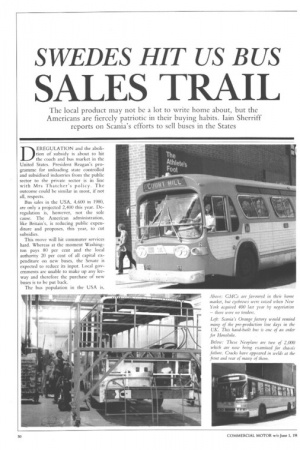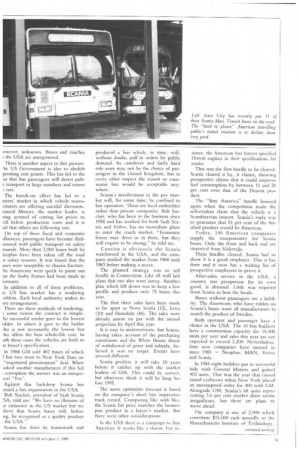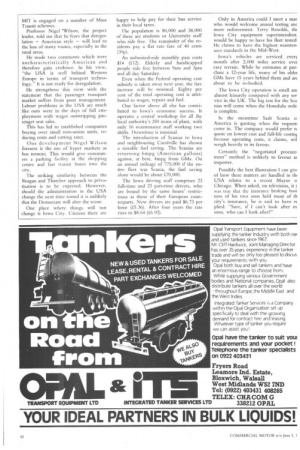SWEDES HIT US BUS
Page 52

Page 53

Page 54

If you've noticed an error in this article please click here to report it so we can fix it.
SALES TRAIL
Thc local product may not be a lot to write home about, but the Americans are fiercely patriotic in their buying habits. lain Sherriff reports on Scania's efforts to sell buses in the States
DEREGULAT1ON and the abolition of subsidy is about to hit the coach and bus market in the United States. President Reagan's programme for unloading state controlled and subsidised industries from the public sector to the private sector is in line with Mrs Thatcher's policy. The outcome could be similar in most, if not all, respects.
Bus sales in the USA, 4,600 in 1980, are only a projected 2,400 this year. Deregulation is, however, not the sole cause. The American administration, like Britain's, is reducing public expenditure and proposes, this year, to cut subsidies.
This move will hit commuter services hard. Whereas at the moment Washington pays 80 per cent and the local authority 20 per cent of all capital expenditure on new buses, the Senate is expected to reduce its input. Local governments are unable to make up any leeway and therefore the purchase of new buses is to be put back.
The bus population in the USA is, owever, unknown. Buses and coaches the USA arc unregistered.
There is another aspect to this picture. 'he US Government is also to abolish perating cost grants. This has led to the ,ar that bus passengers will desert pubc transport in large numbers and return ) cars.
The knock-on effect has led to a uyers' market in which vehicle manuIcturers are offering suicidal discounts. ;eneral Motors, the market leader, is cing accused of cutting list prices to rell below production costs and it is rid that others are following suit.
On top of these fiscal and economic ifluences, passengers have become disilisioned with public transport on safety rounds. More than 2,000 buses built by leoplan have been taken off the road ir safety reasons. It was found that the uses were suseptible to chassis fracture. 'he Americans were quick to point out iat the faulty frames had been made in ;ermany.
In addition to all of these problems, re US bus market has a tendering 7oblem. Each local authority makes its wn arrangements.
There are three methods of tendering. some towns the contract is simple. 'he successful tender goes to the lowest idder. In others it goes to the bidder 'ho is not necessarily the lowest but 'ho offers the best whole-life cost. In oth these cases the vehicles are built to ie buyer's specification.
In 1984 GM sold 402 buses of which but two went to New York State on ‘`negotiated procurement" deal. When asked another manufacturer if this led ; corruption the answer was an unequi)cal "Yes".•
Against this backdrop Scania has Dened a bus organisation in the USA. Bob Sinclair, president of Saab Scania 'SA, told me: "We have no illusions of IT eminence in the US market but we Aieve that Scania buses will, before ng, be recognised as a quality product the USA."
Scania has done its homework and produced a bus which, in time, will, without doubt, pull in orders by public demand. Its cantilever and fairly hard ride seats may not be the choice of passengers in the United Kingdom, but in every other respect the transit or commuter bus would be acceptable anywhere.
Scania's involvement in the psv market will, for some time, be confined to bus operators. These are local authorities rather than private companies. Bob Sinclair, who has been in the business since 1958 and has worked for both Saab Scania and Volvo, has no immediate plans to enter the coach market. "Economic forces may drive us in there, but they will require to be strong," he told me.
Caution is obviously the Scania watchword in the USA, and the company studied the market from 1968 until 1983 before making a move.
The planned strategy was to sell locally in Connecticut. Like all well laid plans that one also went astray. Another plan which fell down was to keep a low profile and produce only 75 buses this year.
The first three sales have been made as far apart as Nova Scotia (12), Iowa (10) and Honolulu (46). The sales were already amost on par with the annual projection by April this year.
It is easy to underestimate, but Scania, having taken account of the purchasing constraints and the White House threat of withdrawal of grant and subsidy, believed it was on target. Events have proved different.
Scania predicts it will take 10 years before it catches up with the market leaders of GM. This could be correct, but observers think it will be long before 1995.
The more optimistic forecast is based on the company's short but impressive track record. Comparing like with like, the Scania list price matches the homespun product in a buyer's market. But there were other considerations.
In the USA there is a campaign to buy American. It works like a charin. For in
stance, the American bus buyers specified Detroit engines in their specifications for tender.
This was the first hurdle to be cleared. Scania cleared it by, it claims, showing prospective clients that it could improve fuel consumption by between 15 and 20 per cent over that of the Detroit product.
The "Buy America" hurdle loomed again when the competition made the self-evident claim that the vehicle is a Scandinavian import. Scania's reply was to guarantee that 51 per cent of the finished product would be American.
Today, 146 American companies supply the componentry for Scania buses. Only the front and back end are imported from Sodertalje.
These hurdles cleared, Scania had to show it is a good employer. This it has done and it now has a waiting list of prospective employees to prove it.
After-sales service in the USA, a country too prosperous for its own good, is abysmal. Little was required from Scania to beat the locals.
Buses without passengers are a liability. The Americans who have ridden on Scania's buses want all manufacturers to match the product of Sweden.
Both operator and passenger have a choice in the USA. The 10 bus builders have a construction capacity for 15,000 units per year and sales this year are not expected to exceed 2,200. Nevertheless, four new companies have moved in since 1981 — Neoplan, MAN, Volvo and Scania.
In 1984 eight builders put in successful bids with General Motors and gained 402 units. That was the year that caused raised eyebrows when New York placed an uncornpeted order for 400 with GM. Alongside GM, Scania's 68 units representing 3.6 per cent market share seems insignificant, but there are plans to move ahead.
The company is one of 2,000 which contribute $15,000 each annually to the Massachussetts Institute of Technology. . MIT is engaged on a number of Mass Transit schemes.
Professor Nigel -Wilson, the project leader, told me that he fears that deregulation — American style — will lead to the loss of many routes, especially in the rural areas.
He made two comments which were uncharacteristically American and therefore gain credence. In his view, "the USA is well behind Western Europe in terms of transport technology." It is not ready for deregulation.
He strengthens this view with the statement that the passenger transport market suffers from poor management. Labour problems in the USA arc much like ours were in the days of full employment with wages outstripping passenger seat sales.
This has led to established companies buying over small non-union units, reducing costs and cutting rates.
One development Nigel Wilson foresees is the use of hyper markets as bus termini. This would give commuters a parking facility at the shopping centre and fast transit buses into the city.
The striking similarity between the Reagan and Thatcher approach to privatisation is to be expected. However, should the administration in the USA change the next time round it is unlikely that the Democrats will alter the scene.
One place where things will not change is Iowa City. Citizens there are happy to help pay for their bus service in their local taxes.
The population is 80,000 and 38,000 of these are students or University staff who ride free. The remainder of the residents pay a flat rate fare of 40 cents (3OP).
An unlimited-ride monthly pass costs $14 (i12). Elderly and handicapped people ride free between 9am and 3pm and all day Saturday.
Even when the Federal operating cost subsidy is taken away next year, the fare increase will be minimal. Eighty per cent of the total operating cost is attributed to wages, repairs and fuel.
One factor above all else has contributed to Iowa's economic success. It operates a central workshop for all the local authority's 250 items of plant, with only 16 maintenance staff working two shifts. Downtime is minimal.
The introduction of Scanias to Iowa and neighbouring Carolville has shown a sizeable fuel saving. The Scanias are returning ompg (American gallons) against, at best, 4mpg from GMs. On an annual mileage of 775,000 if the entire fleet was Scania, the fuel saving alone would be about £70,000.
The Iowa driving staff comprises 23 full-time and 23 part-time drivers, who are bound by the same hours' restrictions as those of their European counterparts. New drivers are paid $6.73 per hour (£5.36). After four years the rate rises to $8.64 0.94 Only in America could I meet a mar who would welcome annual testing ant more enforcement. Terry Renolds, tht Iowa City equipment superintendent. would be happy to have his fleet tested He claims to have the highest maintenance standards in the Mid-West.
Iowa's vehicles are serviced ever) month after 2,000 miles service ovei easy terrain. While he estimates at purchase a 12-year life, many of his oldei GMs have 15 years behind them and art about to be re-bodied.
The Iowa City operation is small an almost leisurely compared with any ser vice in the UK. The big test for the Sea. nias will come when the Honolulu orde is complete.
In the meantime Saab Scania o America is quoting when the request: come in. The company would prefer tt quote on lowest cost and full-life costirq because operating costs, it claims, wil weigh heavily in its favour.
Certainly the "negotiated procure. ment" method is unlikely to favour at importer.
Possibly the best illustration I can giv: of how these matters are handled in th: USA relates to a recent Mayor o Chicago. When asked, on television, it i was true that the insurance broking busi ness of his two sons held most of th city's insurance, he is said to have rt plied: "Sure, if I can't look after m sons, who can I look after?"




















































































